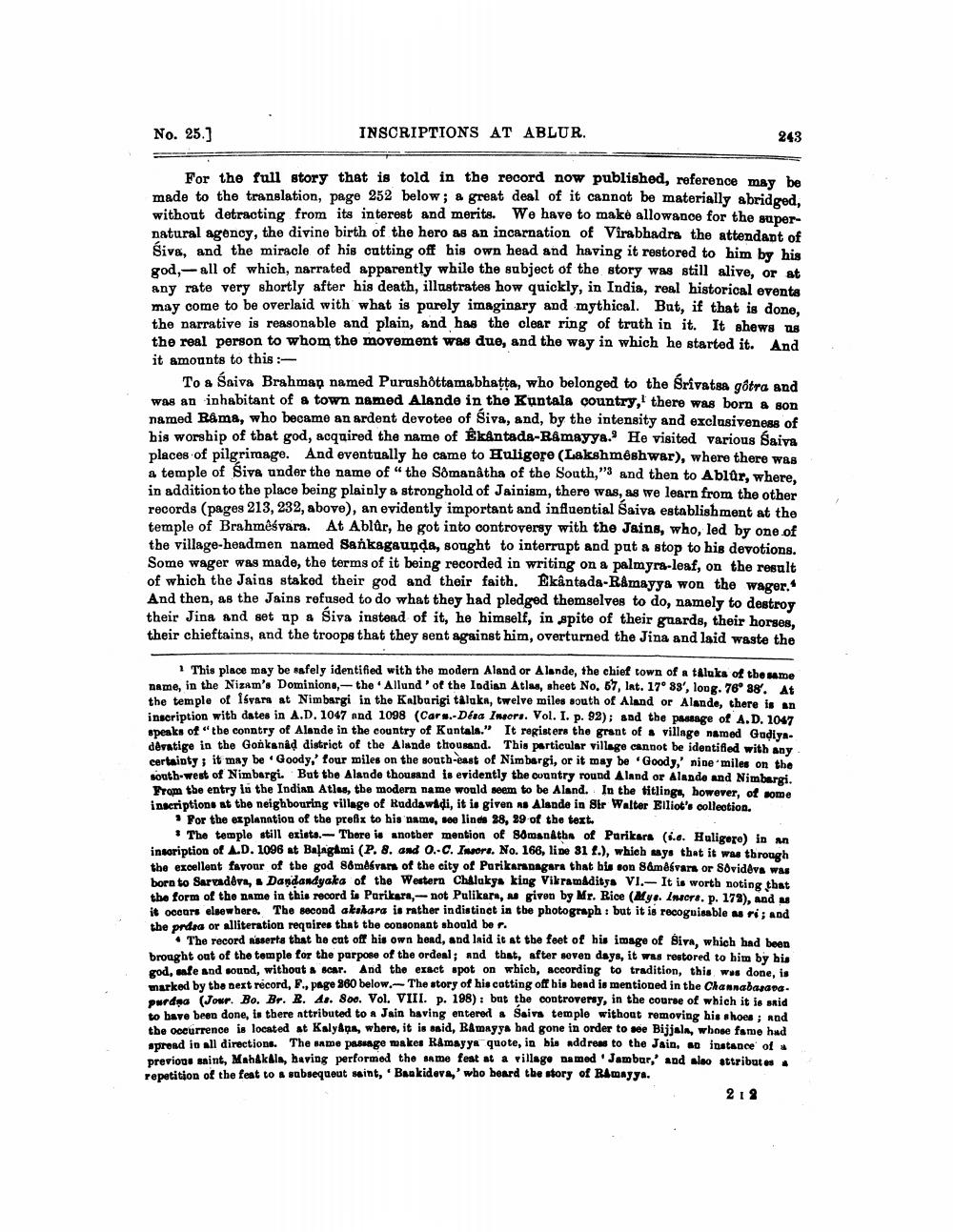________________
No. 25.]
For the full story that is told in the record now published, reference may be made to the translation, page 252 below; a great deal of it cannot be materially abridged, without detracting from its interest and merits. We have to make allowance for the supernatural agency, the divine birth of the hero as an incarnation of Virabhadra the attendant of Siva, and the miracle of his cutting off his own head and having it restored to him by his god,—all of which, narrated apparently while the subject of the story was still alive, or at any rate very shortly after his death, illustrates how quickly, in India, real historical events may come to be overlaid with what is purely imaginary and mythical. But, if that is done, the narrative is reasonable and plain, and has the clear ring of truth in it. It shews us the real person to whom the movement was due, and the way in which he started it. And it amounts to this:
INSCRIPTIONS AT ABLUR.
243
To a Saiva Brahman named Purushottamabhaṭṭa, who belonged to the Srivatsa gótra and was an inhabitant of a town named Alande in the Kuntala country, there was born a son named Rama, who became an ardent devotee of Siva, and, by the intensity and exclusiveness of his worship of that god, acquired the name of Êkantada-Ramayya. He visited various Saiva places of pilgrimage. And eventually he came to Huligere (Lakshmeshwar), where there was a temple of Siva under the name of "the Somanâtha of the South," and then to Ablûr, where, in addition to the place being plainly a stronghold of Jainism, there was, as we learn from the other records (pages 213, 232, above), an evidently important and influential Saiva establishment at the temple of Brahmêsvara. At Ablûr, he got into controversy with the Jains, who, led by one of the village-headmen named Sankagaunda, sought to interrupt and put a stop to his devotions. Some wager was made, the terms of it being recorded in writing on a palmyra-leaf, on the result of which the Jains staked their god and their faith. Ekântada-Ramayya won the wager. And then, as the Jains refused to do what they had pledged themselves to do, namely to destroy their Jina and set up a Siva instead of it, he himself, in spite of their guards, their horses, their chieftains, and the troops that they sent against him, overturned the Jina and laid waste the
1 This place may be safely identified with the modern Aland or Alande, the chief town of a taluka of the same name, in the Nizam's Dominions, the 'Allund' of the Indian Atlas, sheet No. 57, lat. 17° 33', long. 76° 38'. At the temple of Isvara at Nimbargi in the Kalburigi taluka, twelve miles south of Aland or Alande, there is an inscription with dates in A.D. 1047 and 1098 (Cars.-Désa Insors. Vol. I. p. 92); and the passage of A.D. 1047 speaks of "the conntry of Alande in the country of Kuntala." It registers the grant of a village named Gudiyadevatige in the Gonkanad district of the Alande thousand. This particular village cannot be identified with any certainty; it may be Goody,' four miles on the south-east of Nimbargi, or it may be 'Goody,' nine miles on the south-west of Nimbargi. But the Alande thousand is evidently the country round Aland or Alande and Nimbargi. From the entry in the Indian Atlas, the modern name would seem to be Aland. In the titlings, however, of some inscriptions at the neighbouring village of Ruddawadi, it is given as Alande in Sir Walter Elliot's collection.
For the explanation of the prefix to his name, see lines 28, 29 of the text.
The temple still exists. There is another mention of Somanatha of Purikara (.e. Huligere) in an inscription of A.D. 1096 at Balagami (P. 8. and O.-C. Insors. No. 166, line 31 f.), which says that it was through the excellent favour of the god 86mésvara of the city of Purikaranagara that his son Sâmêsvara or Sovideva was born to Sarvadeva, a Dandandyaka of the Western Chalukya king Vikramaditys VI. It is worth noting that the form of the name in this record is Parikara,- not Pulikara, as given by Mr. Rice (Mys. Inscrs. p. 178), and as it occurs elsewhere. The second akshara is rather indistinct in the photograph: but it is recognisable as ri; and the prdsa or alliteration requires that the consonant should be r.
The record asserts that he cut off his own head, and laid it at the feet of his image of Siva, which had been brought out of the temple for the purpose of the ordeal; and that, after seven days, it was restored to him by his god, safe and sound, without a scar. And the exact spot on which, according to tradition, this was done, is marked by the next record, F., page 360 below. The story of his cutting off his head is mentioned in the Channabasava. purdna (Jour. Bo. Br. R. As. Soc. Vol. VIII. p. 198): but the controversy, in the course of which it is said to have been done, is there attributed to a Jain having entered a Saiva temple without removing his shoes; and the occurrence is located at Kalyana, where, it is said, Ramayya had gone in order to see Bijjala, whose fame had spread in all directions. The same passage makes Ramayya quote, in bis address to the Jain, an instance of a previous saint, Mahakala, having performed the same feat at a village named 'Jambur,' and also attributes a repetition of the feat to a subsequent saint, 'Baakideva,' who heard the story of Ramayya.
212




